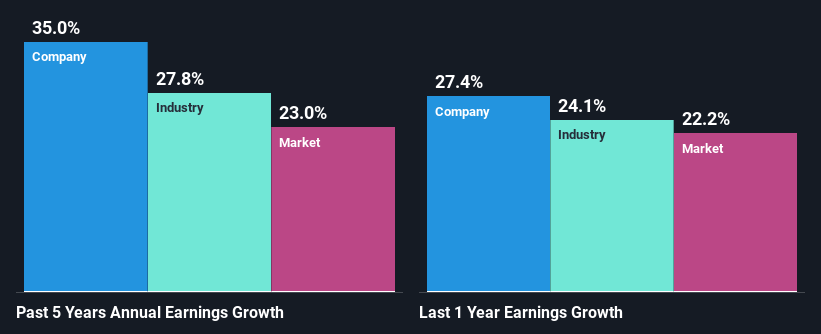- India
- /
- Real Estate
- /
- NSEI:PHOENIXLTD
The Phoenix Mills Limited's (NSE:PHOENIXLTD) Fundamentals Look Pretty Strong: Could The Market Be Wrong About The Stock?
Phoenix Mills (NSE:PHOENIXLTD) has had a rough three months with its share price down 11%. However, stock prices are usually driven by a company’s financial performance over the long term, which in this case looks quite promising. Particularly, we will be paying attention to Phoenix Mills' ROE today.
Return on Equity or ROE is a test of how effectively a company is growing its value and managing investors’ money. In simpler terms, it measures the profitability of a company in relation to shareholder's equity.
See our latest analysis for Phoenix Mills
How Is ROE Calculated?
The formula for return on equity is:
Return on Equity = Net Profit (from continuing operations) ÷ Shareholders' Equity
So, based on the above formula, the ROE for Phoenix Mills is:
11% = ₹14b ÷ ₹124b (Based on the trailing twelve months to June 2024).
The 'return' is the profit over the last twelve months. That means that for every ₹1 worth of shareholders' equity, the company generated ₹0.11 in profit.
Why Is ROE Important For Earnings Growth?
Thus far, we have learned that ROE measures how efficiently a company is generating its profits. We now need to evaluate how much profit the company reinvests or "retains" for future growth which then gives us an idea about the growth potential of the company. Assuming everything else remains unchanged, the higher the ROE and profit retention, the higher the growth rate of a company compared to companies that don't necessarily bear these characteristics.
A Side By Side comparison of Phoenix Mills' Earnings Growth And 11% ROE
At first glance, Phoenix Mills' ROE doesn't look very promising. However, the fact that the company's ROE is higher than the average industry ROE of 7.2%, is definitely interesting. Even more so after seeing Phoenix Mills' exceptional 35% net income growth over the past five years. Bear in mind, the company does have a moderately low ROE. It is just that the industry ROE is lower. Therefore, the growth in earnings could also be the result of other factors. For example, it is possible that the broader industry is going through a high growth phase, or that the company has a low payout ratio.
As a next step, we compared Phoenix Mills' net income growth with the industry, and pleasingly, we found that the growth seen by the company is higher than the average industry growth of 28%.

Earnings growth is an important metric to consider when valuing a stock. It’s important for an investor to know whether the market has priced in the company's expected earnings growth (or decline). This then helps them determine if the stock is placed for a bright or bleak future. If you're wondering about Phoenix Mills''s valuation, check out this gauge of its price-to-earnings ratio, as compared to its industry.
Is Phoenix Mills Using Its Retained Earnings Effectively?
Phoenix Mills has a really low three-year median payout ratio of 13%, meaning that it has the remaining 87% left over to reinvest into its business. So it looks like Phoenix Mills is reinvesting profits heavily to grow its business, which shows in its earnings growth.
Moreover, Phoenix Mills is determined to keep sharing its profits with shareholders which we infer from its long history of paying a dividend for at least ten years. Existing analyst estimates suggest that the company's future payout ratio is expected to drop to 6.1% over the next three years. As a result, the expected drop in Phoenix Mills' payout ratio explains the anticipated rise in the company's future ROE to 14%, over the same period.
Conclusion
In total, we are pretty happy with Phoenix Mills' performance. Particularly, we like that the company is reinvesting heavily into its business at a moderate rate of return. Unsurprisingly, this has led to an impressive earnings growth. With that said, the latest industry analyst forecasts reveal that the company's earnings growth is expected to slow down. To know more about the latest analysts predictions for the company, check out this visualization of analyst forecasts for the company.
New: Manage All Your Stock Portfolios in One Place
We've created the ultimate portfolio companion for stock investors, and it's free.
• Connect an unlimited number of Portfolios and see your total in one currency
• Be alerted to new Warning Signs or Risks via email or mobile
• Track the Fair Value of your stocks
Have feedback on this article? Concerned about the content? Get in touch with us directly. Alternatively, email editorial-team (at) simplywallst.com.
This article by Simply Wall St is general in nature. We provide commentary based on historical data and analyst forecasts only using an unbiased methodology and our articles are not intended to be financial advice. It does not constitute a recommendation to buy or sell any stock, and does not take account of your objectives, or your financial situation. We aim to bring you long-term focused analysis driven by fundamental data. Note that our analysis may not factor in the latest price-sensitive company announcements or qualitative material. Simply Wall St has no position in any stocks mentioned.
About NSEI:PHOENIXLTD
Phoenix Mills
Engages in the operation and management of malls, construction of commercial and residential properties, and hotel business in India.
Excellent balance sheet with reasonable growth potential.
Similar Companies
Market Insights
Community Narratives



